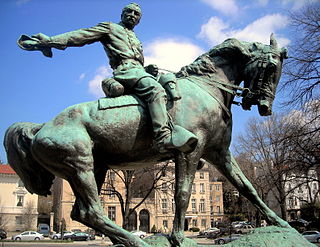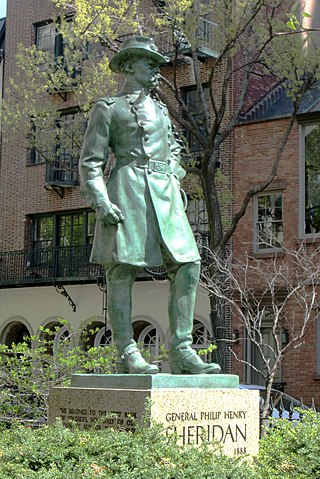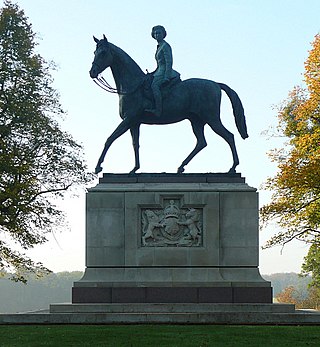Equestrian statue of Philip Sheridan can refer to:
Equestrian statue of Philip Sheridan can refer to:

General of the Army Philip Henry Sheridan was a career United States Army officer and a Union general in the American Civil War. His career was noted for his rapid rise to major general and his close association with General-in-chief Ulysses S. Grant, who transferred Sheridan from command of an infantry division in the Western Theater to lead the Cavalry Corps of the Army of the Potomac in the East. In 1864, he defeated Confederate forces under General Jubal Early in the Shenandoah Valley and his destruction of the economic infrastructure of the Valley, called "The Burning" by residents, was one of the first uses of scorched-earth tactics in the war. In 1865, his cavalry pursued Gen. Robert E. Lee and was instrumental in forcing his surrender at Appomattox Courthouse.
An equestrian statue is a statue of a rider mounted on a horse, from the Latin eques, meaning 'knight', deriving from equus, meaning 'horse'. A statue of a riderless horse is strictly an equine statue. A full-sized equestrian statue is a difficult and expensive object for any culture to produce, and figures have typically been portraits of rulers or, in the Renaissance and more recently, military commanders.
The word equestrian is a reference to equestrianism, or horseback riding, derived from Latin equester and equus, "horse".

Edward Clark Potter was an American sculptor best known for his equestrian and animal statues. His most famous works are the marble lions, nicknamed Patience and Fortitude, in front of the New York Public Library Main Branch

Sheridan Circle is a traffic circle in the Washington, D.C. neighborhood of Embassy Row.

Leonardo's Horse is a project for a bronze sculpture that was commissioned from Leonardo da Vinci in 1482 by the Duke of Milan Ludovico il Moro, but never completed. It was intended to be the largest equestrian statue in the world, a monument to the duke's father Francesco Sforza. Leonardo did extensive preparatory work for it but produced only a large clay model, which was later destroyed.

General Philip Sheridan is a bronze sculpture that honors Civil War general Philip Sheridan. The monument was sculpted by Gutzon Borglum, best known for his design of Mount Rushmore. Dedicated in 1908, dignitaries in attendance at the unveiling ceremony included President Theodore Roosevelt, members of the President's cabinet, high-ranking military officers and veterans from the Civil War and Spanish–American War. The equestrian statue is located in the center of Sheridan Circle in the Sheridan-Kalorama neighborhood of Washington, D.C. The bronze statue, surrounded by a plaza and park, is one of eighteen Civil War monuments in Washington, D.C., which were collectively listed on the National Register of Historic Places in 1978. The sculpture and surrounding park are owned and maintained by the National Park Service, a federal agency of the Interior Department.

Major General George Henry Thomas, also known as the Thomas Circle Monument, is an equestrian sculpture in Washington, D.C. that honors Civil War general George Henry Thomas. The monument is located in the center of Thomas Circle, on the border of the downtown and Logan Circle neighborhoods. It was sculpted by John Quincy Adams Ward, best known for his work on the statue of George Washington in Wall Street, Manhattan. Attendees at the dedication in 1879 included President Rutherford B. Hayes, Generals Irvin McDowell, Philip Sheridan, and William Tecumseh Sherman, senators and thousands of soldiers.

Brevet Lt. General Winfield Scott is an equestrian statue in Washington, D.C., that honors career military officer Winfield Scott. The monument stands in the center of Scott Circle, a traffic circle and small park at the convergence of 16th Street, Massachusetts Avenue and Rhode Island Avenue NW. The statue was sculpted by Henry Kirke Brown, whose best-known works include statues of George Washington in New York and Nathanael Greene in Washington, D.C. It was the first of many sculptures honoring Civil War generals that were installed in Washington, D.C.'s traffic circles and squares and was the second statue in the city to honor Scott.

The equestrian statue of Charles I at Charing Cross, London, England, is a work by the French sculptor Hubert Le Sueur, probably cast in 1633. It is considered the central point of London.

Tomáš Garrigue Masaryk is an outdoor sculpture depicting Tomáš Masaryk, the founding President of Czechoslovakia. It was offered to the United States by the Czech Republic and was inaugurated on Embassy Row on 19 September 2002 in the presence of Czech President Václav Havel, former Slovak President Michal Kováč, and Prague-born former US Secretary of State Madeleine Albright.

General Philip Henry Sheridan, also known as the Sheridan Memorial, is an outdoor bronze sculpture of Philip Sheridan by Joseph Pollia, located in Christopher Park in Manhattan, New York. The statue was installed in 1936.

An equestrian portrait is a portrait that shows the subject on horseback. Equestrian portraits suggest a high-status sitter, who in many cases was a monarch or other member of the nobility, and the portraits can also carry a suggestion of chivalry.

Rumors of War is a series of artworks by Kehinde Wiley examining equestrian portraiture in the canon of Western art history culminating in a bronze monumental equestrian statue by the artist of an African-American young man, created in response to the statue of Confederate General J.E.B. Stuart in Richmond, Virginia in particular and similar statues of high-ranking Confederate Army officers, some of which still stand in the United States despite persistent calls for their removal. Since the installation of Rumors of War in Richmond, all of the statues of the military leaders of the Confederacy have been removed from Monument Avenue where they had been since the first decade of the 20th century.
Statue of Philip Sheridan may refer to:

An equestrian statue of Elizabeth II stands in Windsor Great Park near Windsor, Berkshire. The statue, designed by sculptor Philip Jackson, was commissioned by the Crown Estate in honour of the queen's Golden Jubilee. The monument was dedicated in 2003.

An equestrian statue of Philip Sheridan by Gutzon Borglum, sometimes called the General Philip Henry Sheridan Monument, is installed in Chicago, in the U.S. state of Illinois.